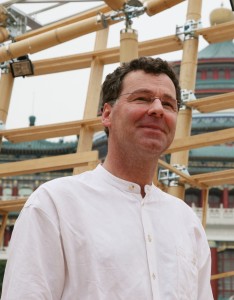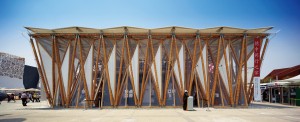Bibhudutta Sahu interviews German installation artist Markus Heinsdorff on his creative vision for Indigenous Terra Madre festival in 2015
His works play with perception of space and dimensions. He takes simple materials like bamboo and crafts masterpieces. Germany based world renowned installation artist and architect Markus Heinsdorff was in Shillong to kick start his work with North East Slow Food and Agrobiodiversity Society (NESFAS) for the second Indigenous Terra Madre festival (ITM) that will be hosted at Mawphlang in 2015.
Eating locally and sustainably produced local food are the main focus of Terra Madre Day, translated Mother Earth Day, which is celebrated all over the world. Terra Madre Day is essentially a campaign to promote the diversity of food traditions and production and works towards building a better food future. The first ITM was held in 2011 in Jokkmokk, Sweden and was Slow Food International’s first event dedicated, entirely, to Indigenous communities where representatives came together from all around the world to share their knowledge of indigenous food.
Markus’ works with bamboo is in keeping with the essence of the event. As a well-travelled artist, he is known to draw inspiration from nature and always looks to craft structures that work in harmony with its surroundings. Trained as a goldsmith and sculptor in Southern Germany, Markus has won several awards for his works which are a culmination of art, architecture and technical innovations.
Amongst his latest known creations in India are 16 different pavilion buildings for the presentation of Germany in India – also called the travelling gems. Markus is also the recipient of the Empowering People Award of the Siemens Stiftung for the invention of a swimming power-plant which provides a low-cost way to generate electricity by using the currents of a river. To add to his many achievements is the authorship of a highly illustrated volume called ‘Design with nature – the bamboo architecture’ that brings out his interest in working with bamboo.
We got a chance to meet up with Markus and share his vision for the ITM 2015
How do you like Shillong?
I have visited many places in India and I have to say that Meghalaya is a very interesting place. The air is fresh, the landscape is beautiful and the people are fascinating.
Were you surprised when you were approached with the project?
I really appreciated it. I look forward to working with the indigenous groups and studying their life. The ITM is one of the top projects for me in the next year.
What inspired you to take on the project?
My brother is an organic farmer and my mother had her own farm, healthy food was always an important matter as I grew up and the aspect of indigenous food being a highlight at the ITM appealed to me. Also, when I began my research I instantly became fascinated with the indigenous lifestyle and history. Being an artist and a designer who works with bamboo, it makes me very happy to be in a place where people traditionally work with this material.
You visited Mawphlang, the venue and met the elders there. What was the experience like?
The first thing that strikes you is a very beautiful valley and a traditional setting with the sacred grove and buildings constructed in a traditional manner. While looking at this valley, the thing that came to my mind was how to design something for a place like this that is right for the place, the people and the project, without disturbing the balance of the place for the sake of the people, the environment and for North East India. We had a meeting with the elders, and although I don’t speak Khasi I liked the demeanour of the people with their welcoming smiling faces.
What’s your vision for the ITM?
The ITM is a huge milestone for NESFAS and the North East India. I feel that we have a great opportunity to do something to touch the people create something extraordinary. The world will be the guest here in 2015. I am prepared to do something not just as a German coming to work here but creating something that incorporates ideas from my background and culture as well as the indigenous culture. I want to present the place with a pearl, a Jewellery for Mawphlang that will make it stand out so it can be understood as the follow up of the travelling gems as a permanent architecture here in North East India. I am planning to work here with bamboo and make it a brand mark in Mawphlang to help the world become a little bit better. My Idea is to give the people an idea of how bamboo can be used practically and innovatively at the same time.
You have worked with gold, wood, stone and bamboo. How does it influence your work?
I started out with gold a very long time ago but the training is coming back to me and now I am working to create a piece of jewellery to adorn Mawphlang. Humans have always liked to beautify themselves, to make things more beautiful or mark themselves to become more visible. It is also a sign of a culture, as we can identify a culture through its jewellery. In the same way our goal is that Mawphlang will be identified through the installation that we will create for the place.
What do you draw inspiration from?
Here I feel very inspired by nature and culture. In my workshops, where I work with many universities, I always ask my students to open their eyes to their own culture and not copy from other cultures. I went to the Don Bosco Museum in Shillong and was very happy to see many bamboo artefacts which are used even today. The handicrafts and their beauty deeply inspired me. If you look at a good bamboo artefact you can see a high-tech futuristic design. Techniques are not too difficult to translate to architectural designs for landscapes. Often simple things when looked through a different perspective can become a huge inspiration. The ITM 2015 will be a chance to inspire the people to learn from tradition and make innovative things.
What is your message to artists and architects?
My message is that you need to believe that there are no limitations to what you can do. Along with that, using your skills for social entrepreneurship can be very fulfilling. When I work I feel I can carry out so many social projects alongside the luxury ones by putting in new technologies that add more importance. That is what makes the world much richer. Take my work with NESFAS for instance where money is not an underlying issue, in fact it is the opposite and yet still very rewarding. Through my work here, I hope, I can inspire people to take up social engagements. If the youth make a career out of saving the environment, it will not only create jobs but also ensure a better future for the world.
 Translate
Translate






